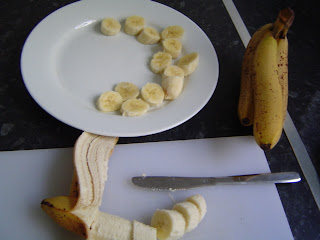If there is anything that the Cantonese and British have in common, it is an appreciation for a good roast. In particular, a good pork roast. Both groups would not say no to moist and succulent porcine flesh topped with crispy and light crackling from the skin of the pig. Where they might differ however is the cut of the animal to use. While the British favour the loin and to a lesser extent, the shoulder, mention roast pork to any Chinese who has barely heard of a roast dinner and the first cut that comes to mind is pork belly. Even as the likes of Jamie Oliver promote the use of the cut in the UK, both groups differ as to their preparation methods. The Cantonese have a more involved process which include blanching the pork skin, marinating in five-spice powder and poking as many little holes in the skin as they can (as opposed to the British approach to simply scoring it). Given that it is Sunday, a day for roasts, and I have two rashers left from my pack of Basics streaky rashers, I thought it would be appropriate to have a go at making siu yuk.
Chubby Hubby describes my sentiment very well - there are too many recipes on the Internet for roast belly pork, each one claiming to have the most excellent results. I guess this is to be expected - Just as the world likes their bacon (which, incidentally, comes from pork belly), they appear to like in almost equal measure their roast pork, and the crackling that comes with it. Given the many ways that people have done this, the supposed ease of execution, and the constraints of my own kitchen, I've come up with my own method, which I will try to document as much as I can below:
After using tweezers or some other mechanism to remove hairs from the skin of the belly pork, we start by blanching the skin of the pork belly in boiling water. Most of the recipes I've come across call for pouring hot water carefully down the skin. I opted for a quicker route and used a shallow pan of boiling water, placing the pork skin down. Try to make the water level as shallow as you can, so that we minimise the amount of pork flesh that gets cooked as collateral.
With the skins cooked, shake and/or pat dry with kitchen towels. Use a sharp object to poke little holes all over the skin (I used a toothpick). Rub five-spice powder all over the flesh, but not the skin, of the belly pork. Leave in fridge to marinate and dry up for as long as you can hold out for, preferably overnight.
Preheat oven to 220 degrees Celsius. Roast the pork, skin side up, for 15-20 minutes, before turning the heat down to 180 degrees for a further 40 minutes. Turn the oven up to 250 degrees for a final 15 minutes of roasting. At this stage, if you want, pour a small amount of rice wine over the pork skin for extra crispiness before the final roasting phase.
I took a few short cuts to bring this to you, including not drying the pork out completely before marinating, and in the case of Chubby Hubby's recipe, using a steam bath in the oven to evenly cook the pork. The result are most apparent in having a rather inconsistent and visually unappealing crackling that looks more like roast pork than siu yuk. It is still crispy and deeply satisfying though.
If you're like my flatmate, who is not very keen on eating Basics meat products, but you still want to try this recipe, you might want to consider the belly pork that is available in the butcher's section of Sainsbury's, or your local butcher. The regular pork streaky rashers do not have any skin to make crackling with.


































